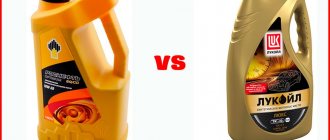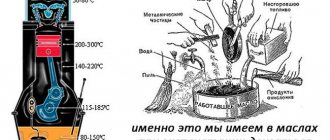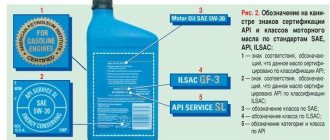Features of two-stroke engines
The operating cycle of an internal combustion engine includes 4 stages: intake, compression, fuel ignition, exhaust gases. In 4-stroke units, each stage is performed in a separate stroke. In 2-stroke engines, the intake, compression and ignition cycles are combined. Such equipment may not have an independent lubrication system: oil is mixed with fuel and goes directly into the combustion chamber. The processes of cleaning and filling the cylinder are combined. Oil is supplied to the combustion chamber in two ways:
- the liquid is poured into the fuel tank along with gasoline, having previously prepared a mixture with a certain ratio of components;
- oil comes from the individual lubrication system in small portions (on more modern equipment).
Two-stroke engines are characterized by high liter power, accelerated piston stroke, and strong heating of parts. Therefore, the requirements for the characteristics of technical fluids for 2- and 4-stroke engines are different.
Functioning of 2-stroke engines
The intake system of most simple two-stroke engines is carburetor. Its difference from four-stroke engines is that the cylinder is purged with a freshly burned fuel-air mixture for two strokes. Since the cylinder is emptied and fuel is supplied at the same time, approximately a third of the fresh lubricant is thrown out along with the exhaust gases.
The consequence of this design flaw is partial combustion of the oil, as well as the generation of a relatively large amount of emissions. Therefore, in densely populated regions with a large number of motorcycles, smog, smoke and noise are observed. Many Asian cities can be cited as examples.
Recently, design deficiencies have been compensated for by a number of advances in two-stroke engine manufacturing technology. Thanks to the development of indirect or direct fuel injection, significant reductions in emissions have been observed. In addition, this allows you to significantly reduce fuel consumption.
We recommend: Car suspension: elements, diagram, types
Requirements for oils for two-stroke engines
Garden equipment, tools, and motorcycles are used in different climatic conditions. The quality of the lubricating fluid directly affects the service life and reliability of motors in difficult conditions. A good 2T oil should have the following characteristics:
- complete burnout without the formation of coke, ash, or deposits;
- maintaining properties in contact with other petroleum products;
- good dissolution and mixing with fuel;
- anti-wear, anti-corrosion, lubricating properties at high temperatures;
- fluidity and pumpability (this characteristic is important for equipment with a separate lubrication system: mopeds, scooters, outboard motors, lawn mowers, etc.);
- environmental Safety;
- compliance with 2T and TC-W standards
It is strictly forbidden to use automobile oils in two-stroke engines. A large amount of additives during combustion forms carbon deposits and ash, which leads to accelerated engine wear. A two-stroke engine will exhaust its life only when using 2T engine oil.
Compound
Various additives are added to oils, which is why two-stroke and four-stroke differ from each other. In addition to the main components, two-stroke oils contain a solvent. It is thanks to it that the miscibility of fuel and oil increases, pumping and atomization are facilitated. But at high temperatures, solvents (20%) negatively affect lubricating properties. Additives increase viscosity, so you should choose a product with a higher viscosity coefficient - this oil is of better quality.
In addition to the solvent, two-stroke oil contains the following substances:
- Oil base - approximately 60%.
- The vacuum residue (the result of the primary distillation of petroleum products) is 5−17%.
- Solvent - 20%.
- Additives that are used to reduce smoke and soot from the waste product - the rest.
Basic properties
The functions of lubricants are:
- prevention of corrosion on parts of the mechanism;
- ideal cooling (heat removal that is created by friction of mechanisms);
- preventing scuffing and improving engine wear resistance;
- reducing friction between engine elements to a minimum.
With the correct selection and use of a lubricant, the engine will last as long as possible.
Source
Standards and characteristics
2T oil for two-stroke engines is intended for air-cooled units. The product is specially colored so that it is distinguishable when mixed with fuel. Most often, oils are red or green, less often blue. The dye does not affect the properties of the material; it is only necessary for visual inspection. Oils for 2T engines are classified according to two international specifications: API and JASO.
Material grades according to API (American Petroleum Institute)
- TA. Oils for low-speed engines with a volume of no more than 200 cm3 (generators, lawn mowers).
- TV. For high-speed engines up to 200 cm3 (chainsaws).
- TS. Oils for engines of small land vehicles: scooters, snowmobiles, scooters.
- T.D. Product for water-cooled motors (jet skis, boats).
JASO (Japanese Automotive Standards Organization) classification
- F.D. Smokeless engine oils with improved environmental performance.
- F.C. Smokeless engine oils meeting standard requirements for use in Japan.
- FB. Products for engines that meet the minimum requirements for use in Japan.
- F.A. Standard quality oils for use in developing countries.
Types of oils for 2T engines
In accordance with the API classification, 2-stroke lubricating fluids are divided into the following types:
- TSC-1 TA - these lubricants are used in small engines with a volume of no more than 200 cm3. Power units of this category are equipped with an air cooling system and are installed on mowers, mopeds, and electric generators.
- TSC-2 TV - this type of lubricant is poured into high-speed motors with a capacity of 50 - 200 cm3. These engines are air-cooled and can withstand high loads. Area of use: chainsaws; motorcycles, scooters.
- TSC-3 TC is a high-quality oil for engines with a volume of 50 - 200 cubic centimeters. These engines are installed on snowmobiles, motorcycles, etc.
- TSC-4 TD - motor oil of this type is poured into outboard power units installed on motor boats where water cooling is used.
Due to the fact that motor boat engines are water-cooled, the lubricants used must meet the stringent requirements set by environmentalists. The main controlled indicators are the ability to quickly biodegrade and prevent the formation of smoke in large quantities.
In accordance with the classification developed by the National Association of Marine Engine Manufacturers, 2T motor oils are divided into classes:
- TS-W.
- TS-WII.
- TS-WIII.
Motorcycle two-stroke lubricants also have their own classification:
- JASO FA.
- JASOFB.
- JASOFC.
Based on their chemical composition, two-stroke oils are divided into mineral and synthetic lubricating fluids. Minerals are produced by refining petroleum products and have a lower price. The quality of 2T mineral lubricants is inferior to synthetic analogues. When exposed to high temperatures inside a running engine, the following characteristics of mineral lubricants are reduced:
- loss of oil thickness, it becomes more liquid;
- loss of lubrication efficiency;
- there is a threat of breakdown of the power unit due to jamming of the rubbing surfaces.
Synthetic two-stroke motor oils have a higher cost. However, their original beneficial properties last longer.
Any brand of 2T lubricant is applicable in various situations and can satisfy the needs of users.
Synthetic or mineral water
Motor oils are made from different base components. The products are:
- mineral . The base is a product of oil refining. Mineral compositions are inexpensive, but demanding in terms of operating conditions. The viscosity of materials strongly depends on temperature; additive packages contain substances that form carbon deposits;
- synthetic . The base for the oil is synthesized in the laboratory. A package of modern additives is added to the composition to improve performance properties. Synthetic oils have stable viscosity-temperature characteristics, effectively lubricate and protect engine parts, but are more expensive than mineral grades;
- semi-synthetic . Mineral and synthetic bases are mixed in a certain proportion. Semi-synthetics are a balance between affordable price and decent performance.
You can only fill the engine with the product recommended by the manufacturer. Do not mix oils of different brands. To switch from mineral fluid to synthetic fluid, you need to flush the engine.
Viscosity, base
2-stroke engines have design features; to ensure their normal operation, it is necessary to select oil that corresponds to the viscosity class specified by the manufacturer of the motorcycle, car and other units. Only the manufacturer can indicate the optimal viscosity for a specific engine type.
If the viscosity is too low, the oil will not protect engine parts from friction - this will lead to wear of the power unit. Using a lubricant that is too thick impairs combustion processes, increases friction losses, and leads to increased carbon formation.
When choosing between mineral and synthetic motor mixtures, follow the rules:
- Mineral water is used in worn-out engines due to the presence of a large amount of carbon deposits in them.
- Synthetics are used in modern drives equipped with an injection or dosage system. Synthetic fluids are characterized by increased properties, so pouring them into power units with high mileage is not recommended.
- Observe the vehicle dealer's approvals and recommendations.
There are BIO oils on the market that have accelerated biodegradation. Their price is 50% higher than conventional lubricants. This cost is due to the ability of combustion products to completely decompose in water; the BIO additive, which is part of these liquids, does not affect the operation of the engine.
Customer Reviews
Considering the reviews about 2T oil left by customers, we can say that high-quality compounds in the middle and high-price categories take care of the system. Apart from price, synthetic oil has no disadvantages. You can purchase this composition at a price of 300-450 rubles/l. It should be borne in mind that the use of mineral oil leads to illusory savings. Since frequent minor and major repairs when using mineral oil will require large financial costs.
It turns out that the synthetic component of the oil allows you to fully satisfy the technical requirements for high-quality lubrication. 2T synthetic based oil is stable and convenient. However, when choosing a suitable composition, be sure to take into account the recommendations of the equipment manufacturer. Her stable work depends on this.
Having considered the features and rules for choosing lubricants for two-stroke engines, everyone will be able to choose the appropriate composition for their equipment.
Types, composition and features of oils for 2-stroke engines
All oils for two-stroke engines have fundamentally the same composition:
- Base - base oil obtained from petroleum or petroleum products;
- Additives are complexes of various components to give the oil the required characteristics.
Mineral and synthetic base oils can be used as a base; the former are obtained by distillation of oil, and the latter - through organic synthesis and other technologies for processing petroleum products and gases. The additive package includes solvents (to increase the ability to mix with gasoline), corrosion inhibitors, viscosity regulators, cleansers (detergents), antioxidants and other components. At the same time, both the base oil and additives are selected in such a way that they do not reduce the quality of the fuel and burn with the formation of a minimum amount of solid soot particles.
Various national and international standards are used to regulate the quality and characteristics of motor oils. Currently, there are four main standards developed by the American Petroleum Institute (API), the Japanese Engine Oil Standards Implementation Panel (JASO), the International Organization for Standardization (ISO) and the National Association of US Shipbuilders (National Marine Manufacturers Association, NMMA).
Most of these standards establish the ash content of lubricants, their degree of solubility in gasoline, operating temperature ranges, cleaning effect and other qualities. The standards also require that the oil be colored blue or another color to reliably identify these materials and visually determine their degree of dissolution in gasoline.
In Russia there is no single standard for lubricants for two-stroke power units; domestic manufacturers use their own specifications, which are often based on the above standards.
It should be noted that many manufacturers of equipment (especially chainsaws, gas mowers, lawn mowers and others) offer their own branded oils for two-stroke engines, which have different markings - HP, HD, XP, etc. However, all these materials in any case comply with one or more of the above standards. Also on oil packages there is the marking “2T”, which only means that this lubricant is intended for two-stroke engines.
How to choose and use the right oil for 2-stroke engines
The use of motor oils for two-stroke power units has its own characteristics. First of all, for engines of various types you can use only lubricants recommended by standards. For example, for motorcycle and snowmobile engines - oils according to APITC, JACO or ISO specifications, and for outboard boat engines - TC-W3 oils. And you should avoid using oils for four-stroke engines - they have a high ash content, and therefore lead to intensive formation of deposits on the piston, coking of the rings and other negative consequences.
Add oil to gasoline only in accordance with the instructions for the unit and lubricant. If oil is to be added to the gas tank, it is recommended to prepare the mixture in a separate canister in the following order:
- Pour half the required amount of fuel;
- Add the required amount of oil;
- Add remaining fuel;
- Mix the mixture thoroughly and pour it into the gas tank.
If a scooter, motorcycle or snowmobile has a separate oil tank, then the lubricant is simply added to it.
It is critical to maintain the proportions of oil and gasoline when mixing them. Depending on the instructions of the equipment manufacturer, the ratio of oil to gasoline can vary from 1:20 to 1:50. To ensure accurate proportions, it is recommended to use measuring cups or purchase oil in cans with a built-in measuring container.
With proper selection of oil and proper mixing with gasoline, the engine of a motorcycle, snowmobile, boat, chainsaw or generator will operate reliably and efficiently in all modes.
Feeling the breath of winter, all motorists are thinking about replacing seasonal tires. And many of us, when buying winter tires, are faced with a difficult choice - “studded” or “Velcro”? Each type of tire has its own advantages and disadvantages, and choosing one over the other can be very difficult. In this article we will try to make this difficult choice.
Filling the tank with low-quality diesel fuel can damage the engine until it completely fails. Special auto chemicals—diesel fuel additives, which are described in detail in this article—help to minimize or eliminate the negative consequences of refueling with low-quality diesel.
Twice a year, all drivers ask one question - when to replace seasonal tires? In the spring, everyone wonders when to install summer tires, and in the fall they are looking for the moment when to install winter tires, and very often drivers make a mistake. Read this article about how to choose the optimal time to replace seasonal tires, and how to avoid making mistakes in this difficult matter.
Heaters and pre-heaters from the German company Eberspächer are world-famous devices that increase the comfort and safety of winter operation of equipment. Read the article about the products of this brand, their types and main characteristics, as well as the selection of heaters and preheaters.
The warm season, especially spring and summer, is the season for cycling, nature walks and family holidays. In the AvtoALL.RU online store you will find everything to make your vacation enjoyable and useful.
The May holidays are the first truly warm weekend, which can be usefully spent outdoors with family and close friends! The range of products from the AvtoALL online store will help you make your outdoor leisure time as comfortable as possible.
It's hard to find a child who doesn't like active play outside, and every child has dreamed of one thing since childhood - a bicycle. Choosing children's bicycles is a responsible task, the solution of which determines the joy and health of the child. Types, features and selection of a children's bicycle is the topic of this article.
Possible consequences of the wrong choice of oil
The careless attitude of owners towards their own equipment leads to the fact that low-quality oil is poured into the engine or a lubricant that is not intended for a specific type of engine is used. As a result, this may lead to:
- to coking of piston rings;
- wear of CPG elements;
- formation of carbon deposits in cylinders;
- the deposition of ash on the tips of the spark plugs, which leads to glow ignition, etc.
When purchasing 2T lubricant for a motor, price should not be a key parameter. Preference should be given to materials from reliable manufacturers who have already proven themselves in the market and can guarantee product quality. Large companies value their reputation; they do not skimp on oil components.
Practical recommendations for using lubricants
It is recommended to mix 2T oils with unleaded gasoline of a grade not lower than AI-90. The requirements for specific equipment should be taken into account. The proportions are most often 1:50, that is, 100 ml of oil per 5 liters of fuel. For mixing, use a canister or other container with measuring indicators. Accurate dosing of components is important. A lack of lubrication will increase engine wear, and too much will lead to the formation of carbon deposits on the spark plugs and pistons.
First of all, gasoline is poured into a clean container. The risk of water and dust entering the liquid must be eliminated. Then add oil to the desired level and tilt the container several times without jerking. After mixing, the liquid will acquire a uniform color (the color depends on the type of lubricant).
Oils 2T JSC "Obninskorgsintez"
– one of the largest manufacturers of motor oils in Russia. We use the latest scientific developments of the Research Institute of Automobile Transport, test products in our own research laboratory, which allows us to guarantee high quality products. Our product range includes 2T motor oils for small-capacity engines of agricultural and garden machinery, as well as lubricants for snowmobiles, motorcycles and other machines.
Our advantages:
- individual commercial offers for representatives of various business areas;
- organization of complex supplies of oils and other materials to meet the specific needs of enterprises;
- special prices for dealers, flexible system of installments and discounts.
To order oils for two-stroke engines, contact the company’s specialists by phone listed on the website. We are always ready to discuss the terms of cooperation.
Oil for two-stroke engines must be selected based on the characteristics of a particular engine. Two-stroke internal combustion engines have a special system for lubricating parts. Which oil to choose, taking into account its features and characteristics. Before you find out, you need to study the design of the unit.











